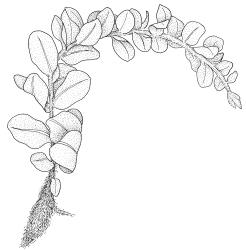Plants mostly robust, usually with plagiotropic, arching vegetative shoots and erect, fertile shoots, lacking secondary pigments in the gametophytes. Stems with a central strand. Leaves of fertile shoots spirally arranged and with a terminal rosette, variable in shape, mostly decurrent, with a unistratose border and singly-toothed; upper laminal cells rounded-hexagonal, firm-walled, sometimes arranged in rows, collenchymatous or not, porose or not. Leaves of arching shoots in two rows, mostly not decurrent. Costa of all leaves strong, ending near or at the apex, lacking teeth abaxially, with an adaxial stereid band.
Dioicous or rarely synoicous (as in N.Z. species). Perichaetia and perigonia (if present) terminal and conspicuous, surrounded by a rosette of leaves. Setae single or multiple, erect and elongate; capsules inclined to nutant, ovoid or obovoid; operculum conic, rostrate or not; peristome well-developed.
According to Koponen (1981), Plagiomnium is a cosmopolitan genus of 24 species. Only P. novae-zealandiae is well documented in N.Z. and south-eastern Australia, although another possible N.Z. representative is discussed below, under "excluded species".
New Zealand material of Plagiomnium (or Mnium s.l.) was treated by some regional authors, including Dixon (1926) and Scott & Stone (1976), as conspecific with the widespread northern hemisphere P. rostratum (Schrad.) T.J.Kop. This species is dioicous and is considered by Koponen (1982, p. 83) to be "invariable enough in North America and Europe to be regarded as a monophyletic taxon".
Koponen has argued (1982, p. 83) that the synoicous inflorescence found in N.Z. material, together with the decurrent leaf bases ("in fertile plants at least"), clearly distinguish it from the widespread northern hemisphere P. rostratum. Koponen proposed three scenarios to explain the evolution of the synoicous P. novae-zealandiae in the "certainly monophyletic" Plagiomnium sect. Rostrata (Kindb.) T.J.Kop. He noted that the 10 species in the section all possess rostrate opercula and stomata that are dispersed throughout the capsule, and considered these to be absent in other sections of Plagiomnium.
| Category | Number |
|---|---|
| Indigenous (Non-endemic) | 1 |
| Total | 1 |
Mnium pseudorhynchophorum Broth. Type material of this name is present in the Paris herbarium (PC 0132767) and is viewable on JSTOR (accessed 8 March 2018). It was collected by T.W.N. Beckett 502 at Waimate, Canterbury L.D., and annotated by Koponen as P. novae-zealandiae (Colenso) T.J.Kop. It is unusual for Beckett not to have retained in his personal herbarium a portion of a collection that he sent to overseas authorities. This name is not considered further.
The name Mnium rhynchophorum Hook. was applied to N.Z. material by J.D. Hooker (1867) and, with a variation of citation, by Dixon (1926). It is a pantropical species and is not considered further here.
Plagiomnium cf. cuspidatum (Hedw.) T.J.Kop. Two sterile shoots of highly aberrant Plagiomnium have been segregated from Hylocomium splendens gathered by Peter de Lange at a high-elevation site at the Upper Makatote River, Mt Ruapehu. This material differs from representative P. novae-zelandiae in several morphological features, as outlined below. It has sterile shoots c. 25 mm in length; leaves elliptic, 3–4 × 1.5 mm, very strongly decurrent, bordered throughout (c. 3 cells wide at mid leaf), and sharply and singly toothed to base. The mid laminal cells are mostly oblong, firm-walled, slightly thickened at corners and c. 18–21 × 12 µm; there is a slight hint of arrangement in rows, and they are slightly more compact near the margins. The costa mostly shortly excurrent to form a short cusp. This combination of characters suggests that a second N.Z. species of Plagiomnium is to hand, but using such sparse and asexual material specific assignment is very difficult. The high-elevation collection site is more than 1000 m higher than any other North I. collection of Plagiomnium, although it is only about 300 m higher than the highest South I. records of P. novae-zelandiae. Using the key characters employed by Smith (2004), the Upper Makatote River material approaches in many ways his concept of P. cuspidatum. However, the distribution of marginal teeth (extending to the leaf insertion) agrees more with Smith’s fig. 207 than with his description. Additional high-elevation collections may clarify the identity of the Upper Makatote River material. It is filed, for convenience, as P. cf. cuspidatum (Hedw.) T.J.Kop., CHR 587434.




